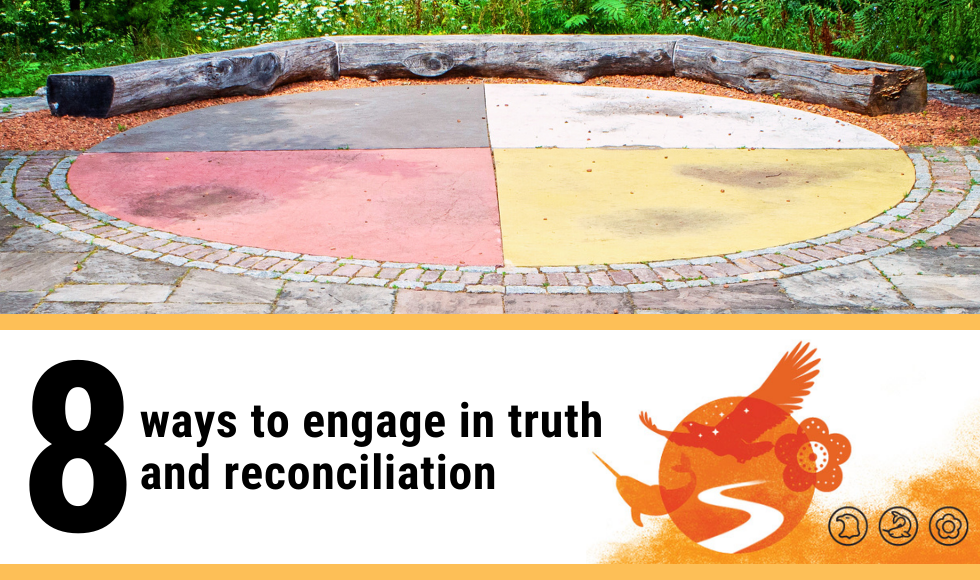8 ways to engage in truth and reconciliation

“Together, Canadians must do more than just talk about reconciliation; we must learn how to practice reconciliation in our everyday lives – within ourselves and our families, and in our communities, governments, places of worship, schools and workplaces. To do so constructively, Canadians must remain committed to the ongoing work of establishing and maintaining respectful relationships.”
– National Centre for Truth and Reconciliation
The National Day for Truth and Reconciliation is a time for non-Indigenous people to pause and acknowledge the history and ongoing effects of the residential school system in Canada and reflect on individual responsibility and action. It is also a day to look at the ways in which settler colonialism, a particular form of colonization where the people who settle in a place remain their indefinitely, continues to impact the lives of Indigenous peoples in Canada. Reconciliation is an ongoing process that needs to be incorporated into every day of the year, not just September 30.
Here are 8 ways that non-Indigenous people can engage with the process of reconciliation:
1. Recognize the word Indigenous refers to diverse and distinct nations
Indigenous is a collective name for First Nations, Inuit and Métis peoples, which includes hundreds of distinct and independent nations across the country (and even the world), each with unique histories, traditions and languages.
You should ask those you interact with how they identify and learn the names of the nations on whose land you live and work. Avoid using terms that can be derogatory and offensive that homogenize and denigrate Indigenous peoples.
When engaging with the process of reconciliation, it is important to remember the diversity among First Nations, Inuit and Métis peoples.
2. Learn the history between Indigenous and non-Indigenous peoples
Before we act, we must first learn. The stories and voices of Indigenous peoples must be highlighted in our educational systems and are integral in dismantling the colonial point of view traditionally taught in the Canadian school system. The relationship between Indigenous and non-Indigenous people has been one of imbalance and injustice. It can be uncomfortable to learn about this history and to acknowledge how much of Canadian history minimizes and erases Indigenous peoples and how current policies continue to reinforce a colonial world view.
There is no Canadian history before Indigenous peoples but there is Indigenous history before Canada. It is important to remain mindful of this when engaging with the process of reconciliation.
3. Understand the history and legacy of residential schools
Indian Residential Schools* sought to “destroy Indigenous cultures and languages and to assimilate Indigenous peoples so they no longer existed as distinct peoples” (Truth and Reconciliation Commission, 2015). For over 150 years, Indigenous children were forcibly removed from their families and sent to these schools, with the last school not closing until 1996. It is both a long and recent history.
To engage with the process of reconciliation, we must acknowledge residential school experiences, impacts and consequences, including the intergenerational trauma experienced by Indigenous peoples.
4. Explore the unique intersections we have between treaty, constitutional, Indigenous and human rights in Canada
Indigenous and non-Indigenous peoples have different relationships with the Canadian government. The legal rights of Indigenous peoples have changed since Europeans first arrived on Turtle Island, from the Doctrine of Discovery to Confederation and the subsequent Indian Act* – these legal “rights” were based on the needs of the colonizers, not the intrinsic rights of Indigenous peoples.
The Canadian Constitution and, to a much greater extent, the United Nations Declaration on the Rights of Indigenous Peoples have sought to assert the inherent rights of Indigenous peoples. To fully engage with the process of reconciliation, time and attention must be given to the power and agency that Indigenous nations are reclaiming, what that looks like and why it is important.
5. Recognize the rich contributions that Indigenous peoples have made to Canada
Canada is indebted to the diverse cultures and nations of Indigenous peoples and the rich history and knowledge they have contributed to Canada, including the country’s name (which likely comes from the Huron-Iroquois word “kanata,” meaning village or settlement) and our collective identity as a country.
According to the Calls to Action, supporting Indigenous peoples’ “cultural revitalization and integrating Indigenous knowledge systems, oral histories, laws, protocols and connections to the land are essential to the process of reconciliation.”
6. Take action to address historical injustices and present-day wrongs
Before taking action, it is important to engage with anti-racism training. Anti-racism training teaches how to address unconscious biases about Indigenous peoples and unlearn harmful stereotypes. This type of education also provides the necessary tools to act in a culturally sensitive and well-informed way.
Before acting, it is important to reflect on why you are taking action, the affects you hope to achieve with these actions and how you will include Indigenous peoples in your actions.
7. Teach others
Teaching others what we have learnt is a crucial step in engaging with reconciliation, as it deepens our own learnings and understanding and helps create a community of culturally safe people. When teaching others, it is important to refer and guide individuals to Indigenous sources of knowledge and information. While we can begin to teach people about the importance of reconciliation, and all that we have learnt, we must ensure it is grounded in the voices and knowledge of Indigenous peoples.
8. Create a culturally safe environment
To better understand the systemic structures of oppression and the importance of dismantling them, non-Indigenous people must learn about the treatment of Indigenous peoples within institutional environments, like schools and hospitals, and how anti-Indigenous racism has been embedded into policy and practice. With cultural safety training***, people can carefully and critically learn about the oppressive social structures within these institutions and how they impact the health and education of Indigenous peoples. Individuals and institutions can then begin to create and support equitable environments that are culturally safe and Indigenous-informed.
Creating a culturally safe environment is an important step in creating a culturally safe Canada, wherein Indigenous peoples are included in all spaces, without barrier and with access to traditional knowledge and practices.
This compilation of ways to engage in truth and reconciliation has been created in collaboration with the Indigenous Health Learning Lodge (IHLL) and using insights drawn from the following sources:
- 6 Actions of ReconciliACTION
- Atlohsa Family Healing Services
- Calls to Action**
- National Centre for Truth and Reconciliation
- Reconciliation Education
- Truth and Reconciliation Commission of Canada
- United Nations Declaration On The Rights Of Indigenous Peoples
- Whose Land
Anti-Racism Education
- 4 Seasons of Reconciliation Course
- Advancing Re(al)conciliation Course
- Certificate in Reconciliation Studies
- Indigenous Canada Course
- San’yas Indigenous Cultural Safety Training Program
Support for Indigenous staff, faculty and students
- Hope for Wellness Help Line
- Indian Residential Schools Resolution Health Support Program*
- Indigenous Health Learning Lodge (IHLL)
*The term ‘Indian’ when used to describe First Nations people is derogatory and offensive. This language is used here as it is still used by the government of Canada within its legislation.
** Calls to Action booklets are available in the Indigenous Health Learning Lodge’s little learning library.
*** The IHLL has developed a training called “Culture of Safety”. If you are interested in learning more about this program, please email them


